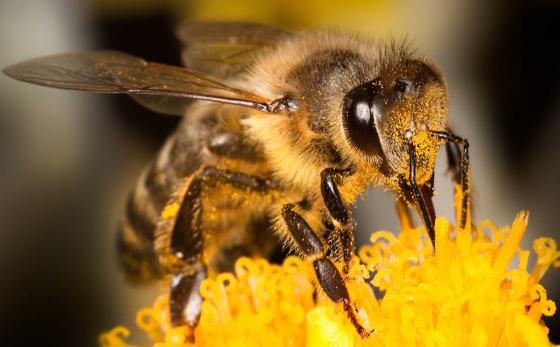Green Building Community
What’s Happening to the Bees?
Posted by: Matt Z. // Student

Pollinators serve a very important role in agriculture. Grasses such as wheat and corn are pollinated by the wind, but most other native crops require pollination by bees or other pollinating animals. Among other important foods, these crops include broccoli, apples, oranges, onions, carrots, avocadoes, and the list continues. It is estimated that bees pollinate around $15 billion in U.S. crops and additionally produce around $150 million in honey annually. So maintaining our bee population is crucial to both our diets and also our economy. However, in 2006, beekeepers started to notice a mass disappearance of bees from their colonies. About one third of U.S. bee colonies have disappeared and the bee population is lowest it’s been at in the past 50 years.
The NRDC lists the following as some potential cause for this mass disappearance:
Global warming causes flowers to bloom earlier, so when bees come out of hibernation, the flowers that provide them with the nutrition that they need to start the season have already bloomed.
Some pesticides that are meant to kill pests can also harm bees. Neonicotinoids, a class of pesticide, work there way into the pollen and the nectar of a plant, making them extremely harmful to the bees. Even though the pesticide exposure over one season is not expected to be lethal to bees, long time exposure can quickly become fatal. Even if the bees do not die from prolonged exposure to neonicotinoids, they are expected to experience other detrimental effects such as changes in foraging behavior, reduced predator avoidance or delayed development. These sublethal effects have been observed even at low pesticide exposure.
A lot of bees are also experiencing habitat loss due to development, abandoned farms, and farmers growing crops without providing a habitat for wildlife.
Parasites such as harmful mites are also killing bees.
There are several ways in which policy makers and farmers can take action towards this mass bee disappearance:
Farmers should be rewarded for pursuing practices that help protect the bees such as leaving habitats for bees in their surrounding fields, alternating crops so that bees have food all year round and not using harmful pesticides.
Bee research by the USDA and the EPA must be strengthened and expanded to also study pollinators other than bees.
Integrated Pest Management (IPM) techniques should be used to minimize pesticide use and risk to bees. These techniques include introducing beneficial insects that prey on pests, disrupting pests’ habitat and using the least toxic pesticide when necessary. IPM has been proven to be an effective method to get rid of pests while minimizing risks to pollinators; however, it is not widely used. According to the NRDC, the USDA has the ability to better promote and implement IPM, but is not doing it in as widespread of a manner as it should, especially in some regions with serious pesticide impacts.
Here are some ways that you can help bees on the local level:
Plant bee friendly flowers and flowering herbs in your garden and yard. You can find which local plants are pollinator friendly by clicking here.
Don’t be so eager to remove all weeds from your yard. A lot of plants that are considered to be weeds, such as dandelions, are actually local flowering plants that are important food sources to North American bees.
Don’t use chemicals and pesticides to treat your lawn.
Buy local and raw honey. Find your local beekeepers and support the work that they do to preserve bees in your area.
Even bees get thirsty! Put out a water basin in your yard so that they can stop by for a drink after feeding on your flowers.
Please be kind and respectful!
Please make sure to be respectful of the organizations and companies, and other Rate It Green members that make up our community. We welcome praise and advice and even criticism but all posted content and ratings should be constructive in nature. For guidance on what constitutes suitable content on the Rate It Green site, please refer to the User Agreement and Site Rules.
The opinions, comments, ratings and all content posted by member on the Rate It Green website are the comments and opinions of the individual members who posts them only and do not necessarily reflect the views or policies or policies of Rate It Green. Rate It Green Team Members will monitor posted content for unsuitable content, but we also ask for the participation of community members in helping to keep the site a comfortable and open public forum of ideas. Please email all questions and concerns to admin@rateitgreen.com

